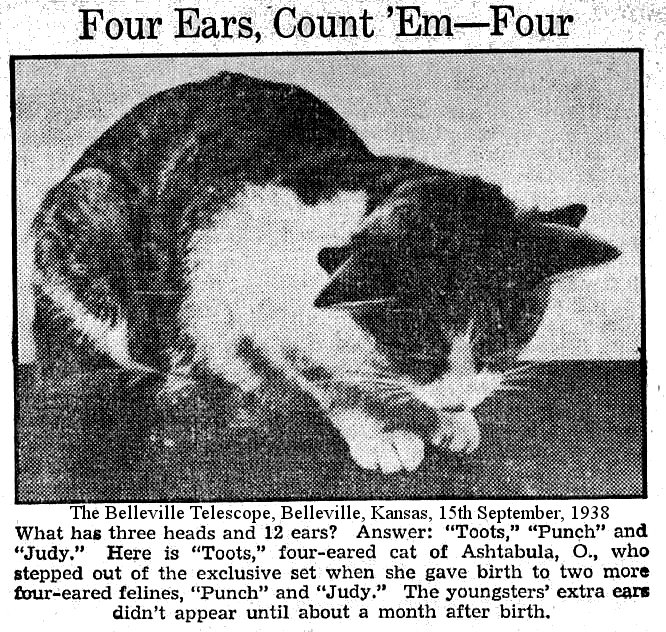
FELINE MEDICAL CURIOSITIES: THE EARS
Anomalies of the Ears
Note: Contrary to suggestions on some bulletin boards, the images here are not photoshop. With the exception of those labelled as artist's impressions these are photos of medical conditions. These pages are intended as a medical reference site. Offsite links to images on these pages is not supported - bandwidth costs money!
DUPLICATED EARS
The earliest report I can find of a four-eared cat is in "Cat Gossip," 15th May, 1929: " 'Unsere Katze' relates that a voting Russian tramp is always accustomed to take a blue tom cat with him on his wanderings. He found it as a half-starved kitten in the ruins of Moscow; short of food himself, he managed to rear the kitten, which now provides for him, entering houses through the window and stealing provisions, which it shares with its human friend. This cat has four ears; a cat belonging to a Viennese publican had four ears and two tails, this freak was sold for 600 dollars to America."
Another early report described Toots of Ohio, USA, also known as the Ashtabula Four-Eared Cat. The Belleville Telescope, Belleville, Kansas, September 15, 1938 reported 'What-has-three-heads-and-12-ears?- Answer:-"Toots," "Punch" and "Judy." Here is "Toots," four-eared cat of Ashtabula, O.,' who stepped out of the exclusive set when she gave birth to two more four-eared felines, "Punch" and "Judy." The youngsters' extra ears didn't appear until about a month after birth.' and the Shamokin News-Dispatch, Shamokin, Pennsylvania, Monday, November 28, 1938 wrote 'ASHTABULA, Ohio (U.R) Toots, the four-eared cat, may have her title as the only genuine four-eared cat voided and by her offspring, too. She has a son and daughter, Punch and Judy, who have two extra fuzzy tips alongside their regular ears.'

The press release sent to those, and many other, papers gave a bit more detail about Toots, whose supernumerary ears appeared to be genetic and heritable. "Ashtabula, Ohio - Toots is no longer the only four-eared cat in the world but she gained the distinction with losing her title. Toots you see, had kittens 'Punch' and 'Judy' each have two extra fuzzy tips alongside the regular ears. The youngsters extra ear sets appeared about a month after their birth, but the feather-like growths haven't sprouted enough yet to be picture-able. As the only four-eared feline, 'Toots' was spared from the stuffing room of the National Museum in Washington last month when Mrs George Wood, her owner, declined a $100 offer for the pet."
Another four-eared kitten was reporetd under the headline IF IT COULD HEAR YOU TALK, CAT MIGHT SAY ALL THE BETTER TO HEAR YOU WITH in the Chicago Tribune, 12th December 1968
A feline freak possibly, but more likely the four-eared kitten born this fall in McHenry is the first of a new breed of cats, said Dr. Daniel Fasnacht, 134 S. Milwaukee av., Libertyville. The kitten was brought to Fasnacht s attention when the animal and his four brothers and sisters were brought to the Pet Shop, 1914 Grand av., Waukegan, in mid-November, said Mrs. Vera [William] Meyer, the shop-owner. The McHenry resident who brought the kittens to the shop knew that one of the kittens had four well-developed ears and the others each had two ear buds, but the resident did not want to keep the kittens, said Mrs. Meyer. I called Dr. Fasnacht that day and told him about the kitten, said Mrs. Meyer. He spent the remainder of the week-end doing research on four-eared animals.
I checked the University of Illinois publications to see if there were any freaks or animals with abnormalities with four ears in the medical records, said Fasnacht, a veterinarian who was graduated from the University of Pennsylvania. There is nothing in medical records on four-eared animals, but that does not mean they ve never existed, he said. I consider the kitten's extra ears more of a mutation rather than the result of a freak occurrence, said Fasnacht. The reasons are because the ear flaps [according to Fasnacht, ears are actually ear flaps] are functional. In freaks the extra appendages would be non-functional, he said. Fasnacht also pointed out that if the kitten were a freak the extra ears would have separate ear canals. He said after examining the kitten he found that there is only one ear canal for each set of ears. A mutation occurs when there is either some chemical or physical mix-up in the genes and chromosome make-up of the animal, or when nature decides that some characteristic would be of benefit to the animal and nature directs the occurrence, said Fasnacht.
The real test will come when the kittens are bred with each other to see if the mutation is a dominant part of their makeup, said Fasnacht. If the extra ears appear in the new kittens, then the new appendages will be a mutation. If not, Fasnacht said it will prove the now living kittens are freaks. The extra ears sit at 45-degree angles from the regular ears. They look like butterflies, said Mrs. Meyer. If a new breed of cats is developed, I may call it the butterfly breed, she said. The kitten, which Mrs. Meyer plans to keep along with all his brothers and sister, is an American domestic cat, but not a purebreed. Altho she has not named the kitten yet, Mrs. Meyer said she is considering calling him Alfa [meaning first or beginning] Quad [four] and whatever the Latin word is for ears [auris]. I d call him Alfie for short, she said. The kitten is beautifully marked, said Mrs. Meyer of the gray-toned kitten who has a white chin, chest, and paws. He has extra-long whiskers and eyelashes. The kitten has a very nice personality, said Mrs. Meyer when asked if the kitten tends to be mean. He loves to play, jump, and balance.
Since the kittens arrived at the shop, Mrs. Meyer said the town people are as excited about the kitten as she is. bring their Mrs. Meyer added that entire classrooms of school pupils come to see the kitten. People are always coming to the shop to see the kitten including grandparents who bring their grandchildren, said. Fasnacht added that entire classrooms of school pupils come toe see the kitten.
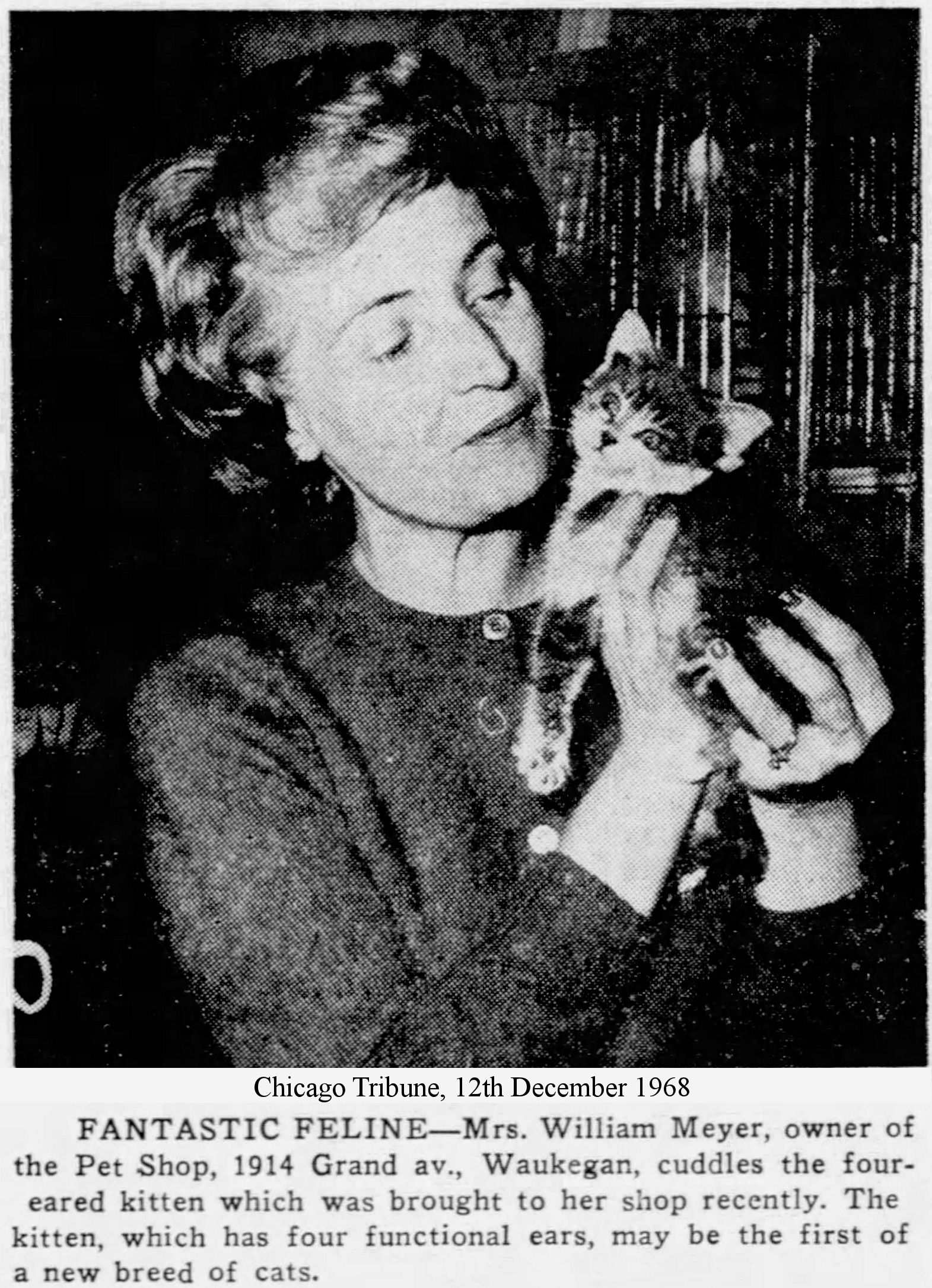
In December 1978 a cat with four ears was reported in Chattanooga, Tennessee, USA. The deformity was first studied in 1957 and is called, unsurprisingly, "four-ears" because the cat has a small extra pair of "ears" or at least extra ear flaps. In the cats studied in 1957, the eyes were reduced in size and the jaw was slightly undershot giving the head a peculiar shape. The kitten's growth and eventual size were normal, but the cat seemed to be relatively inactive and lethargic. Researchers believed that the functioning of the brain was also affected. The Four Ears trait is a recessive condition and therefore remains hidden unless a kitten inherits two genes for the trait. In a test-mating, two cats with four ears, when bred together, produced 100% four eared kittens - normal for a recessive gene - but the fact that it is so rarely seen suggests that kittens which inherit two genes die in the womb. (Little, CC. Four-Ears, A Recessive Mutation In The Cat. The Journal of Heredity, Vol XLVIII , March-April 1957, No 2 Pg 57 )
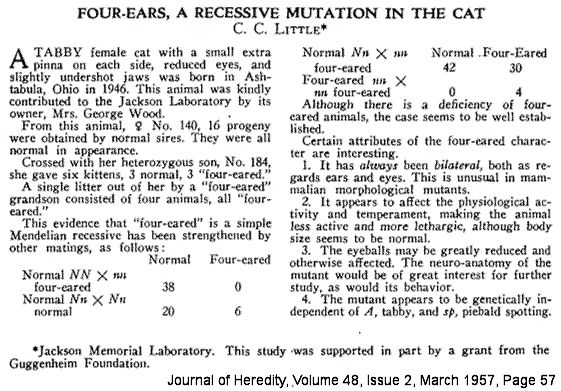
Not all Four Eared cats die before birth, and the extra ear flaps can be placed differently, which suggests various genes can cause (or influence) this trait. Some may be due to developmental mishaps in the embryo rather than genetics. A four-eared cat was exhibited at a British cat show in the late 1990s and apart from the smaller, extra ears it was apparently quite normal.
DUPLICATED EARS - CONFORMATION AND CAUSES
As with many physically similar traits, there may be several different genetic mutations. The Chattanooga and 1957 cats may have had a different deformity to more recently reported four-eared cats which are otherwise normal. Alternatively, there may be a single mutation with variable expression - different degrees of deformity ranging from cosmetic through to damaging. In humans, there have been cases where extra auricles (earlobes) were present below the normal ear but did not have an ear canal. reported forms are: additional "lobes" to ear flaps, additional ears not connected to normal ear flaps. The exact placement/alignment of the additional ears may also differ.
|
|
|
|
|
A secondary set of smaller ear flaps (pinnae) is set behind functional ears. and not connected; there may be rudimentary middle ear structure (artist impression). |
Secondary smaller flaps set to outside of main ear flaps. Usually the main ear flaps and secondary ear flaps are connected and in some cases are simply lobes of the main ear flap. |
Pinnae are lobed; extra ear flaps at right-angles (in some cases back-to-back) with normal ears, do not appear to be mobile independently of main ear flaps. Normal middle and inner ear structure associated with main ear flaps and not duplicated (extra ears sometimes have "blind" openings). The cat is reportedly physically and mentally normal and the extra pinnae could be cosmetically removed. |
Ewa Enderleit in Denmark has a 4-eared cat called Joey. The vet believes this to be due to the mother, 2 year old Scottie, being given hormone tablets as no-one was aware she was pregnant until her single female kitten, Joey, was born on the night between September 1st and September 2nd 2003. A mummified foetus was later removed during spaying. LINK TO SELECTIVE BREEDING FOR LONG SKULL SHAPE It is possible that some of the "extra ear flaps" are strange folds and may be linked to selective breeding for large ears and for how ears are positioned in Oriental breeds. They are bred for the long skull shape and this will affect structures of the skull and face e.g. unusual ear flaps, small deep-set eyes. Selective breeding has changed the shape of Persians and introduced structural changes, this might be a similar thing in Oriental breeds due to selective breeding for changed skull shape. Similar changes are found in the Bull Terrier. Alfie is a 4-eared Oriental cat from Chanelle's Quintessence. This is his breeder s description: When he was born, we were shocked, in the full sense of the word. Never, from the word at all, have I heard of or seen anything like this. This kitten was distinguished from the rest not only by an extra pair of ear shells, but also by an extremely long body, and the shape of a head resembling that perfect drop from a sci-fi films, and its eyes were extremely small. It was clear that we were encountering a mutation, but unfortunately, no information was found about it, except that 4 ears pull reduced eyes behind them. To date, we have 3 such kittens growing up in our nursery. So I will briefly share with you my observations. 1. These kittens have a very long nose, a long body, a long neck. The Bull Terrier and modern Oriental/Siamese are both selectively bred for elongated noses. The profile has changed from concave with a stop (or saddle ) at the nose bridge, to convex with a bump at the nose bridge and downward pointing muzzle. In addition, large wide-set ears are desirable in Oriental cats. Selective breeding for this head conformation affects the shape of the eye-sockets and musculature of the head. In cats, this may be associated with unusual development of ear flaps and small eyes. A ROUND-UP OF RECENT CASES In March 2004, a six-month old cat with four ears was put up for adoption at an animal shelter in Murnau, southern Germany. Lilly was born on a farm in Bavaria and has an extra pair of slightly smaller ear-flaps behind her normal ears. This unusual trait is a rare gene mutation; the extra ears do not have any hearing ability. The front ears are completely normal. None of Lilly's littermates were affected. Many farm cats in the area are not neutered. Lilly has since been adopted by a family who already had cats from the same shelter and who did not intend to exhibit her as an oddity. 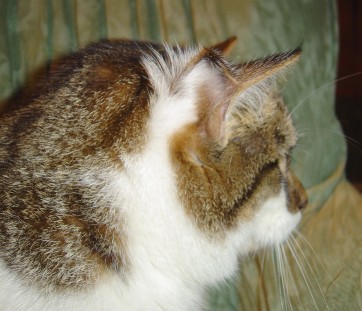
Joey. Photo copyright Ewa Enderleit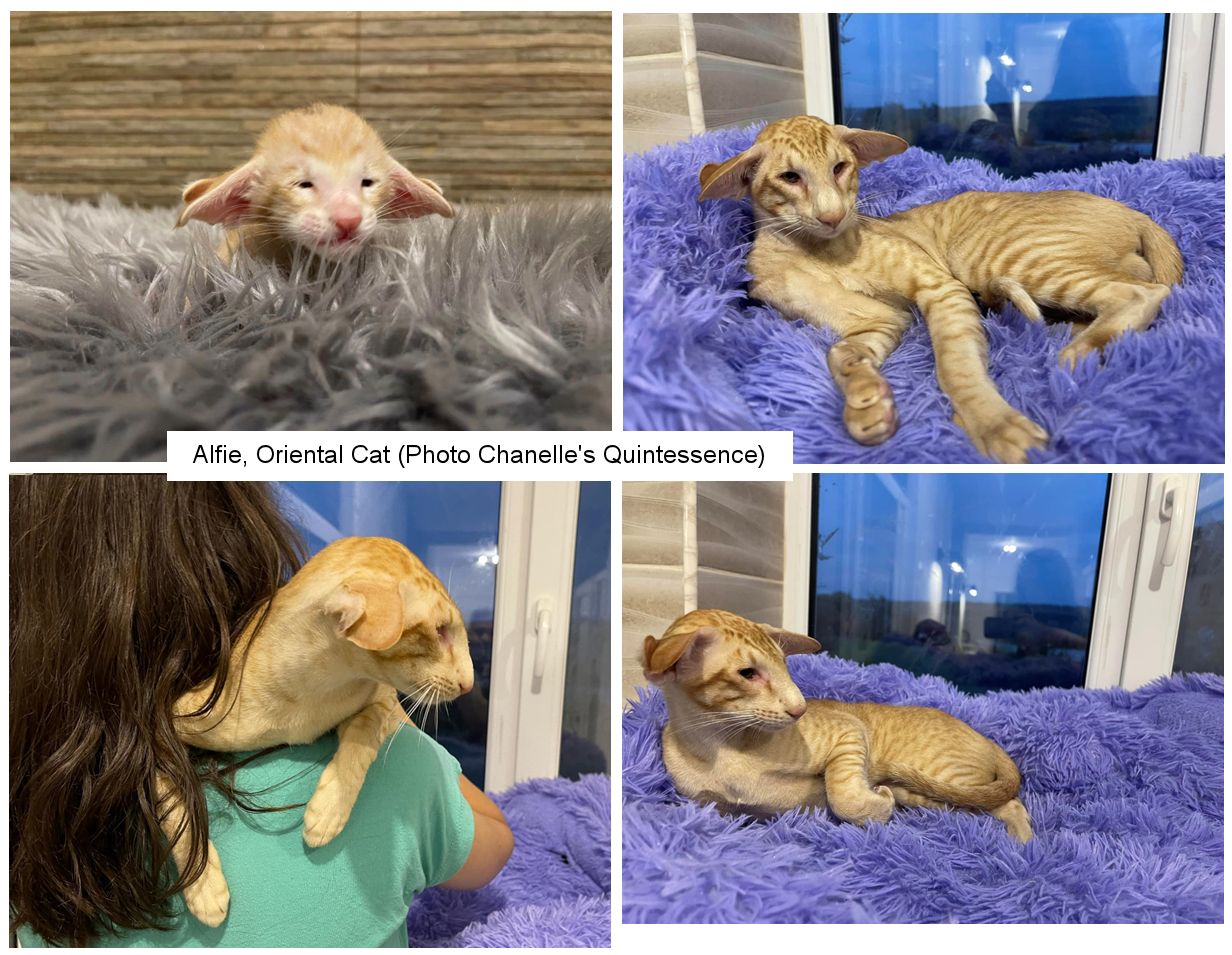
2 The ears of these kittens are incredibly large, with a very dense cartilage at the base of the ear, two eardrums have collapsed into one, which looks like bud petals. And as a rule, the upper one is always much brighter than the lower one.
3 Kittens are born with very small eyes that for a long time, even after opening, are closed by the third century, so you might think that the kitten is blind. And only in the process of growth, the third century decreases, the eye opens. Eyes, as a rule, are of different size for a long time, and are completely aligned visually to the year. The eyes are deeply planted, which requires regular eye hygiene. Given exclusively the information that the eyes are reduced, it can be assumed that such kittens can be born with limited vision or with a deficiency of it.
4. Alf is already an adult cat, incredibly loved by everyone, he has 100 percent vision, 100 percent hearing, 300 percent appetite, an amazing coefficient of arrogance and magnetism. 
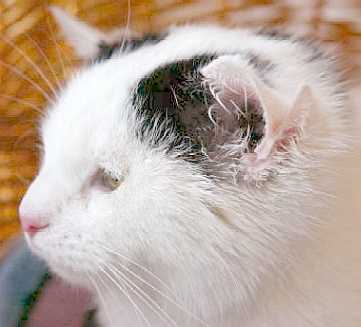
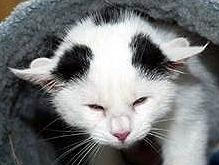
In March 2004, the Russian news agency Pravda reported an unusual kitten born to two ordinary domestic cats in the Samara Region. The kitten had seven ears instead of two. At first, the owners noticed the kitten had three ears: two normal ears and a third one inside one of the normal ears. The kitten was named "Three". Several months later the owners discovered additional ears when they bathed the cat. The supernumery ears were normal in appearance apart from being very small and poorly developed. The cat had two small ears inside a big one and two ears on its cheek. The seven ears give the cat no problems - in fact it seems unaware of them. It is claimed to have especially good hearing, but mostly when called for meals! The female ginger kitten below (unnamed at the time of writing) was born in Brackley, England in summer 2004 and has one set of normal ears and a second set of smaller, fully formed pinnae. She also has the small eyes and undershot chin seen in the Chattanooga cats, but unlike them she is intelligent and very lively with no sign of brain damage. She has 2 littermates with the normal complement of ears, but is the boldest of the litter. Her parents are described as "town cats" and it is unknown whether they were related or inbred. (Photos copyright Adam-l)
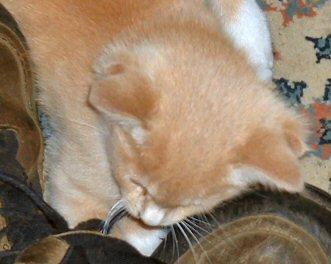
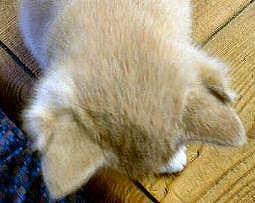
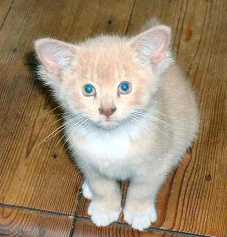
In October 2004 I received an update from Adam: "Her name....Bug-a-Lugs. Seems to fit not just her physical characteristics, but spot on for her personality too. She is still extremely lively and intelligent, always watching what's going on and talking, insisting on being taken for walks, chasing her tail and bouncing off walls. I would suggest that she is actually abnormally intelligent, which would support the belief that the affected allele has an effect on the brain (albeit in a positive sense in her case). Her pupils are almost always fully dilated, giving her a staring look. They do, however, respond to bright light. I guess that this could be due to either an abnormality in the eye or the brain. She has grown but, I suspect, will always be a fairly small cat. When she runs down stairs, with her 4 ears horizontal from her tiny head, I swear she looks like she could get airborne. Could this be the next stage in feline evolution, catching birds on the wing?" Adam also mentioned another 4-eared kitten which indicates a genetic, rather than a developmental, trait: "And one last piece of news. She now has a rival, another 4-eared cat has been born to the same mother! This kitten has now gone to a home in Brackley."
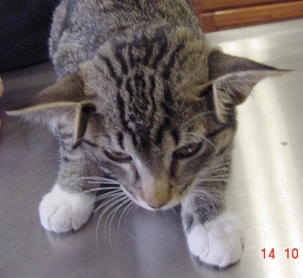
This 4 eared cat is tabby-and-white Gizmo from Lafayette, USA whose story was released on October 19, 2004. He was a barn cat, probably descended from dumped cats, and was rescued by the Bowen family. His intriguing deformity is probably due to extensive inbreeding according to Dr. Sharon Ellman-Murray, DVM. Gizmo has been adopted as NCISN poster kitty promoting responsible spay and neuter to prevent overpopulation. Although Gizmo's deformity is endearing and not harmful, inbreeding can lead to more serious problems. Gizmo's photo and information were kindly provided by Dr Sharon Ellman-Murray. Unlike the other 4-eared cats shown here, Gizmo's extra ear flaps appear to be inside his normal ears and facing in the opposite direction. The additional ears do not have ear canals associated with them. Following a veterinary exam, Gizmo was reported to be completely normal in all other respects and has a normal sister. He is active with no sign of mental retardation.
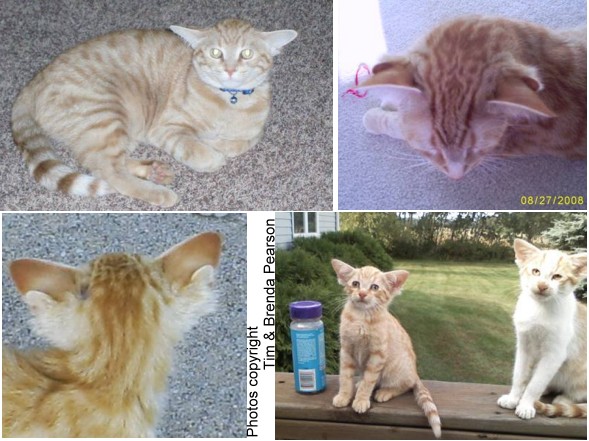
Yoda and his brother were born on Brenda Pearson's parents' farm in Capron Illinois in May 2007, and out of a litter of 4, both male kittens had four ears. This indicates a genetic trait, probably similar to Bug-a-Lugs/Freaky mentioned earlier (the facial shape is also similar). Yoda now lives in Belvidere, Illinois with Tim and Brenda Pearson. The Pearsons' vet found a home for his brother Ted who is apparently a successful exhibition cat. Sadly their mother and female littermates were killed by another animal and Yoda had teeth-marks and ripped skin from the attack and also a ball-bearing in his jaw from being shot at. His extra ears are only visible from the side and back of his head. Yoda's personality is extremely outgoing, loving, playful and well-mannered (he comes when he's called by name, he's never aggressive, always uses his litter box, and has learned to stay off the tables and countertops). He also appears to have above normal intelligence.
Yoda is a popular name for cats with 4 ears. This Yoda (previously named Barfly) belongs to Valerie and Ted Rock. They were in a Chicago bar in 2006 and saw a grey kitten being passed around curious fellow drinkers. They adopted the 8 week old kitten from his owner and named him Yoda. Their vet was mystified by his unique appearance and found information on the web. The extra ear-flaps (non-functional) are situated behind the normal (functional)ear-flaps and are not attached to the base of the skull, nor do they appear to have ear canals. The skull is broader than normal, giving him a triangular face. Yoda has normal hearing and behaviour and the presence of the extra flaps appears to be cosmetic. Interestingly, the functional ears have rounded tops which is unusual for a domestic cat, while the non-functional ears have a more normal pointed appearance.
In August 2011, news agencies reported a four-eared Russian kitten called Luntik that lives at a service station in Vladivostok. The supernumerary ears are not functional and are just ear-flaps. Some papers have nicknamed Luntik the "Jedi cat".
In November 2021, a four-eared four-month-old random-bred grey cat from Turkey (not a Russian Blue as sometimes reported) called Midas, appeared on Instagram. Midas s mother, a stray cat, gave birth to her and her six siblings in a garden belonging to a friend of Canis who adopted the unusual cat.
|
|
|
|
Jen Wesh (2013) of Joa's Arc Rescue, Audubon, New Jersey has a four-eared cat named Kreacher. Kreacher, who has his own Facebook page Kreacher the 4 Earred and Fabulous Cat , was born in southern New Jersey, USA, in the Spring of 2011. He was taken into the animal shelter at around 6 weeks old with his two completely normal siblings. Kreacher's extra ears are not functioning ears and are connected to an ear canal. His normal ears are rather large and his ear canals are long and thin and need regular cleaning. In addition to additional ear flaps, he has some other issues including juvenile cataracts, some facial deformities and paralysis, and he's very petite for an adult cat. This indicates that there are several causes of 4 ears in cats, with different side-effects. Kreacher's facial appearance and the conformation of his ears is similar to that of ginger Yoda. A three-eared cat was found in Norfolk, England in November 2015. He had strayed or been abandoned near a garage and was taken in by Feline Care Cat Rescue, in East Harling, Norfolk who named him Brian and is thought to be between four and eight years old. He almost ended up with a Star trek themed name because he has a left ear, a right ear and a final front-ear . Another 4-eared feline was reported in August 2016. A 3 year old black cat named Batman became an internet star after the four-eared feline was found at the Western Pennsylvania Humane Society shelter. Batman s second set of ears is said to be the result of a recessive genetic mutation. The condition has been documented since at least 1936, when a four-eared cat named Toots was found in Ashtabula, Ohio, according to the Western Pennsylvania Humane Society. Just hours after that news was announced, he was adopted by a family with a young daughter. In July 2021, the media reported a 4-eared polydactyl tabby cat called Aslan in Pennsylvania. Aslan has extra ear flaps behind his true ears. Swati Komanduri adopted Aslan who was rescued from a car repair shop along with several other kittens. The extra ear flaps are an unusual formation of the tissue at the base of the normal ear flap and Aslan also has the unusually wide-set ears of many four-eared cats. ABSENT EAR FLAPS In addition to multiple ear-flaps, some cats have been born with no external ear structures. This has been seen in a Persian cat and may have been associated with inbreeding for the modern ultra-type. The cat's middle and inner ears were intact and it was not deaf. Lack of outer ear affects a cat's ability to pinpoint sound - something cats do by swivelling their ear-flaps much like radar detector dishes. Many of the ear-less cats around are due to removal of the ear-flap because of skin cancer caused by over-exposure to strong sunlight (especially in pale coloured cats as these lack protective pigment).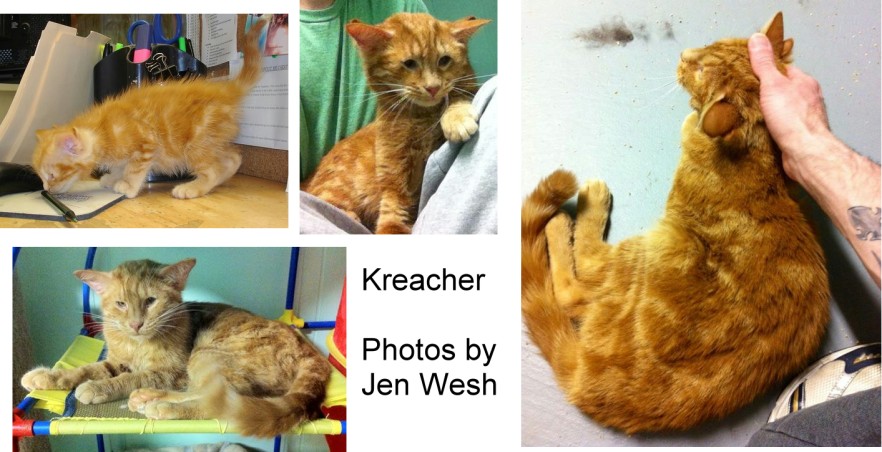
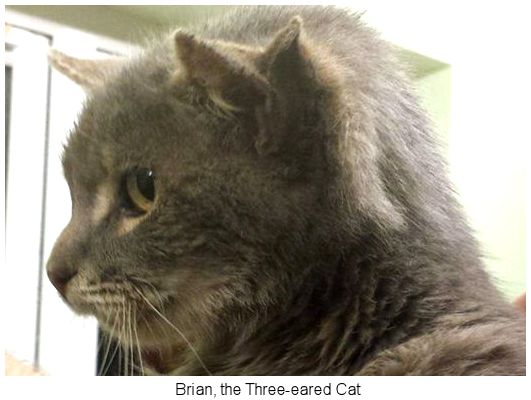
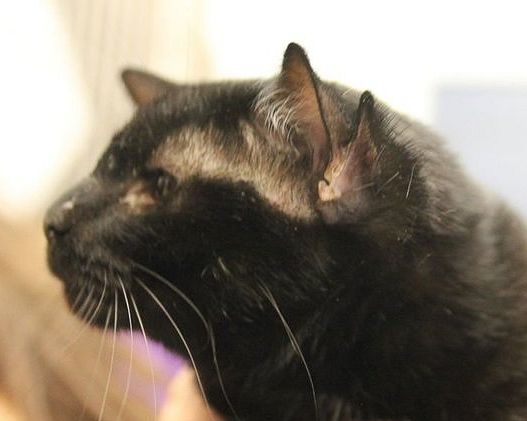
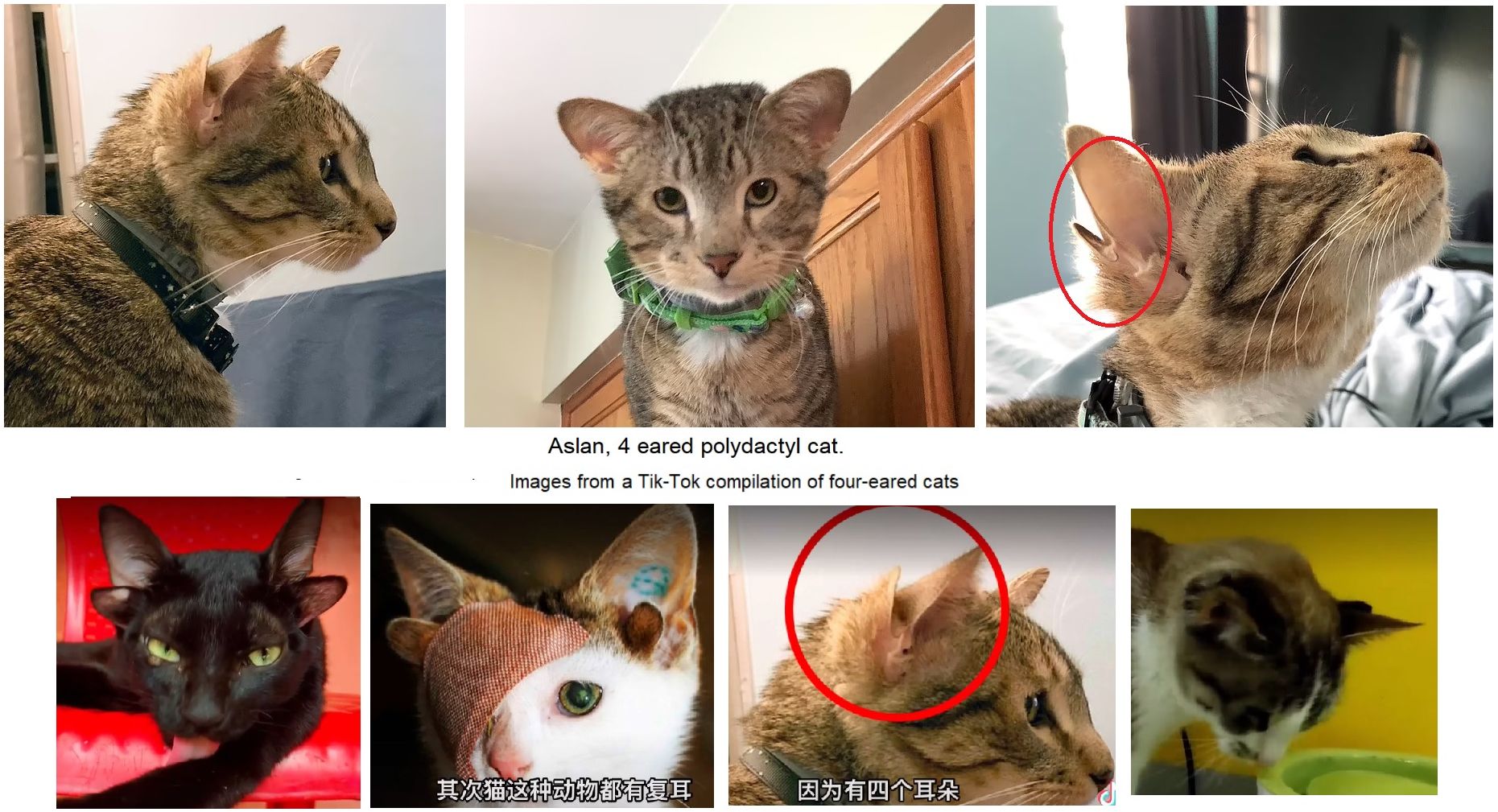

In January 2008, Myndi D, who works at a vet clinic and also fosters rescue cats provided these photos of a longhaired cat born without ear pinnae. The kitten was found by her neighbour in Lehi, Utah. She is about 4-5 months old (when photographed) and named Emma. Myndi's first thought was that the ears had been cut off, but there is no scarring. Emma has no other abnormalities and can hear well.
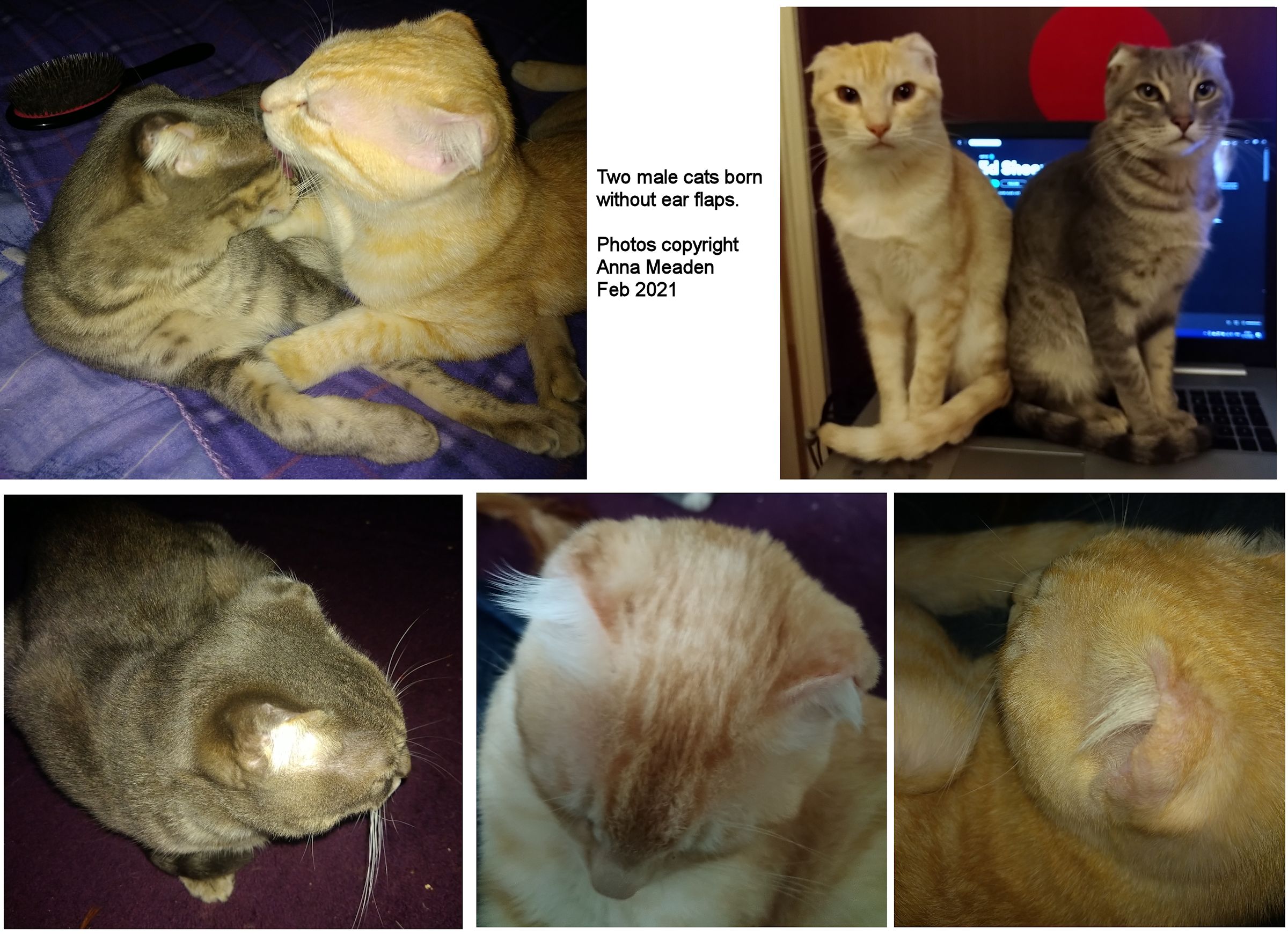
In February 2021 I received details of two brothers lacking ear flaps from birth. Anna Meaden adopted two brother kittens (about 9 months old) from Qatar. They don't have ear flaps apart from the base. The rescue took them in when their Mum who was a stray was run over by a car when the kittens were about 3 weeks old.
SMALL-EAR MUTATION
Characterization of an Inherited Neurologic Syndrome in Toyger Cats with Forebrain Commissural Malformations, Ventriculomegaly and Interhemispheric Cysts, MK Keating, BK, Sturges, S Siso, ER Wisner, EK Creighton, LA Lyons, in J Vet Intern Med. 2016;30(2):617 626.
A small-eared male Oriental cat was imported from Italy to the USA to found a line of cats with small, rounded ears to use in developing the Toyger breed. The small, rounded ears appeared desirable to improve the tiger-like appearance of the breed. The male was mated to at least 4 mixed breed, unrelated female domestic cats, producing only normal-eared offspring with each. The F1 female offspring were then backcrossed to the short-eared male, producing some offspring with normal ears and some with short ears. Kittens from brother-sister matings produced similar results. Pedigree analysis showed the mutation to be an autosomal recessive i.e. not sex-linked. Short-eared females showed normal sexual behaviour, but never became pregnant when mated to short-eared males, carrier males or completely unrelated males. The foundation male was (obviously) fertile as were carrier males and females.
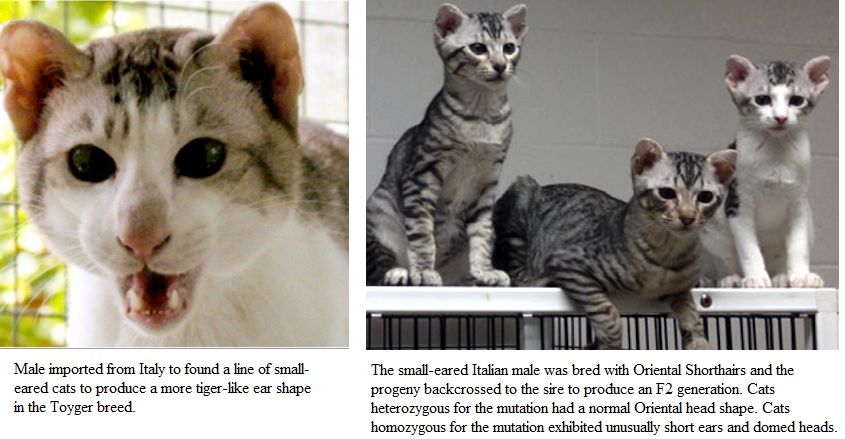
The short-eared kittens were clumsy and MRI scans found them to have marked ventricular dilatation and associated anomalies. 20 related Oriental-derived crossbred Toyger cats weres from the breeding programme were donated to UC Davis for study. Seven were clinically healthy carriers and 13 were cats showing neurological signs, short ear phenotype and complex brain anomalies ( affected cats ). MRI scans were performed on all of the cats. Following diagnostic studies, the cats were destroyed and their brain anatomy was studied. The affected cats had structural brain abnormalities such as ventriculomegaly, cysts and multiple midline and callosal malformations. The affected cats had varying degrees of dilated ventricles (fluid filled regions of the brain) and thinning of the cerebral cortex. The affected cats did not have the normal pattern of ridges and furrows on the brain surface these were much shallower and had an abnormal pattern. The degree of shallowness corresponded to how severely the cat was affected. These congenital brain defects were found to underlie the neurologic signs observed in those cats selectively bred for the short ear phenotype.
There was an update to this study about small ears: A Deletion in GDF7 is Associated with a Heritable Forebrain Commissural Malformation Concurrent with Ventriculomegaly and Interhemispheric Cysts in Cats
Yoshihiko Yu, Erica K. Creighton, Reuben M. Buckley, Leslie A. Lyons and 99 Lives Consortium
Genes 2020, 11, 672
An inherited neurologic syndrome was documented in a family of cats involving forebrain commissural malformation, concurrent with ventriculomegaly and interhemispheric cysts. Commissural fibres connect the two hemispheres of the brain. Ventriculomegaly means the brain has enlarged fluid filled cavities. Interhemispheric cysts are fluid filled bodies between the 2 hemispheres of the brain and are associated with defective development of the bundle of nerve fibres that connect the two hemispheres and allow the left and right sides of the brain communicate with each other (corpus callosum).
It was inherited as an autosomal recessive syndrome. Forty-three cats were genotyped. A homozygous mutation was found in Growth Differentiation Factor 7 (GDF7) in affected cats. This was not found in 192 unaffected cats in the 99 Lives dataset. GDF7 is important in the development of neurons in the mammalian brain. A genetic allows cat breeders to identify carriers so they are not used in breeding.
During the development of the Toyger cat, in which small rounded ears are desirable, a mixed breed cat from Italy, with Oriental ancestry, with small rounded ears was used as a foundation sire. Outcross and backcross breeding found the small ear trait to be inherited as an autosomal recessive. MRI scans of a rounded-ear kitten following an accidental head injury due to a fall, showed there was congenital hydrocephalus. MRIs of the breeding stock suggested cats with small round-ear phenotype and domed heads had congenital brain malformations.
(Keating, M.K.; Sturges, B.K.; Siso, S.;Wisner, E.R.; Creighton, E.K.; Lyons, L.A. Characterization of an Inherited Neurologic Syndrome in Toyger Cats with Forebrain Commissural Malformations, Ventriculomegaly and Interhemispheric Cysts. J. Vet. Intern. Med. 2016, 30, 617 626.)
The cats with small rounded ears were clumsy and mildly unco-ordinated when walking. They had normal limb reflexes and normal cranial nerves, but their brains had abnormalities as described above. The findings resembled a mild form of holoprosencephaly (HPE) in humans. HPE means the brain doesn t properly separate into 2 hemispheres. Most affected cats also had hydrocephaly (excessive fluid in the skull). There were no chromosomal abnormalities. It is a recessive trait and is not sex-linked. The owner of the cats halted the breeding programme and neutered the cats. Some cats were presented to the researchers for pathologyl and genetic studies. Cats with normal sized and shaped ears had no clinical signs. The cats with small rounded ears showed characteristic clumsiness.
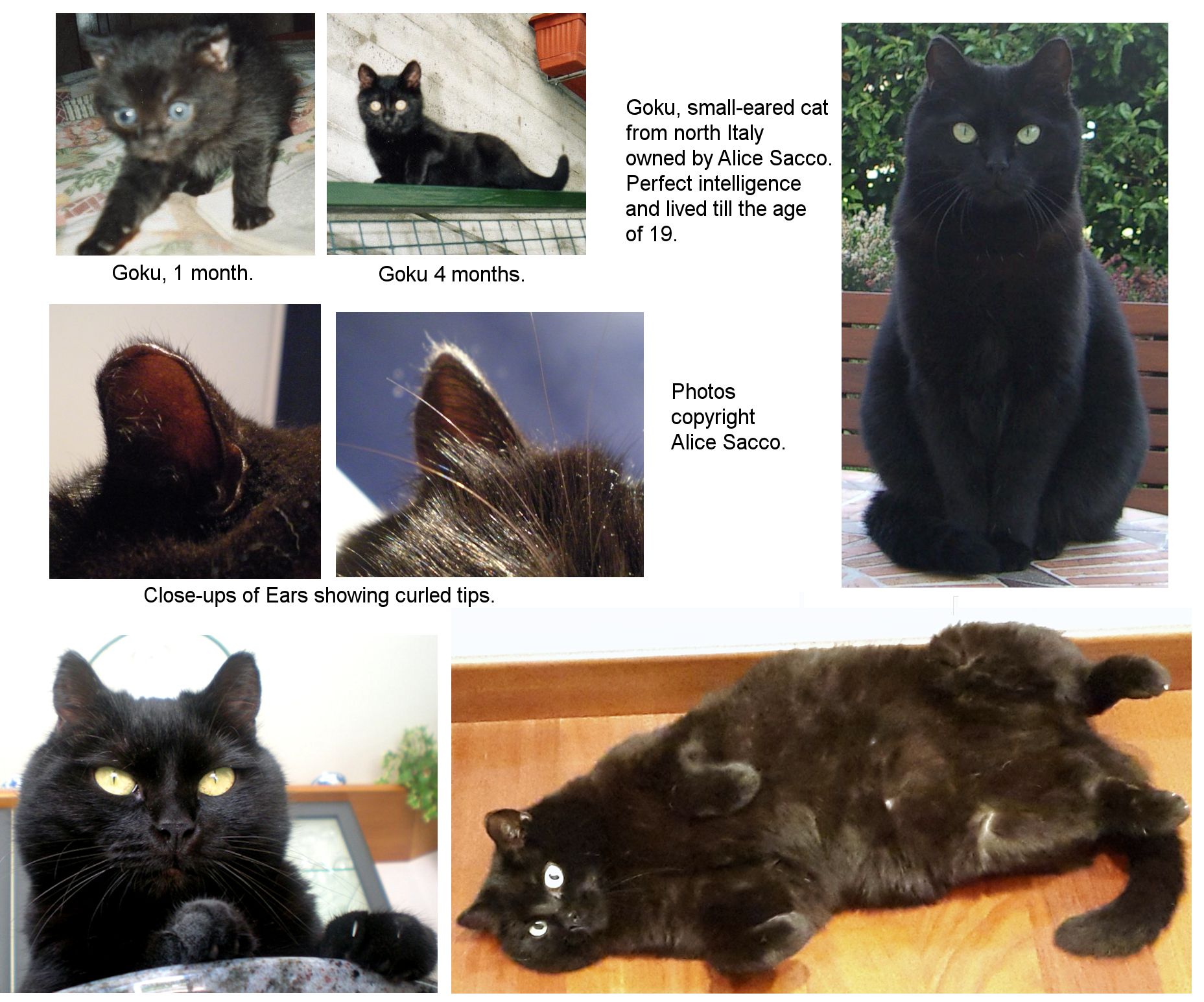
In 2020 Alice Sacco from north Italy wrote to me about Goku, a female cat she had for more than 19 years. Goku s ears remained folded until she was about 3/4 months old. She grew up to be a quite big cat, close to weighting 5 kilos, but her ears remained small, shaped like those of a newborn kitten for her whole life. Unlike the family of small-eared cats, Goku was very smart and very good at solving problems, right up until the end of her life. Her mother (blue-cream longhair) and her half-sister had normal ears (blue short-hair). The father was a black cat. Although Alice was curious to see if the small ears were hereditary, she had Goku spayed at 18 month for her own wellbeing. Goku s half-sister was born sterile.
UNUSUAL CURLED EARs
Kuchisake Onna from Brunei Darussalam provided these photos of an unusual curl-eared kitten adopted in 2016. The skull shape is also a bit unusual and might indicate a chromosome abnormality. The parents are both domestic shorthairs with normal ears. None of the littermates have the curled ear shape.

And these photos from Jelena Nekrasova also show an unusual ear shape.

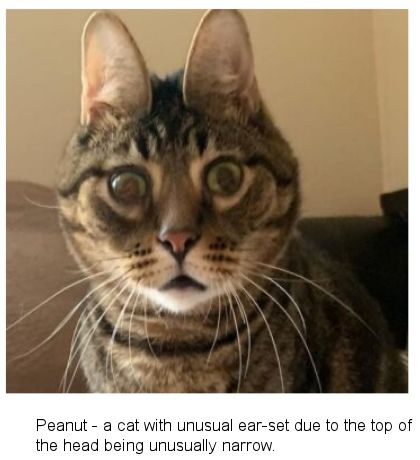
CURLED EARS AND FOLDED EARS
Two mutant ear forms have been fixed as breed traits. One is the Scottish Fold, where the ears are folded forwards. The other is the American Curl where the ears are curved backwards as though windswept. A "lop-eared" variety of cat (the Sumxu) once existed in China, but is now extinct. Fold-eared cats have occurred spontaneously in Essex, England and The Hebrides, Scotland. A curl-eared cat occurred in Australia. These are detailed at Curled, Curved and Folded Ear Cats . The type of cat known in China in antiquity as "four-eared cats" were not four-eared at all; the name derived from the long ear furnishings of long-haired cats which gave them the appearance of having extra ears inside their normal ones.
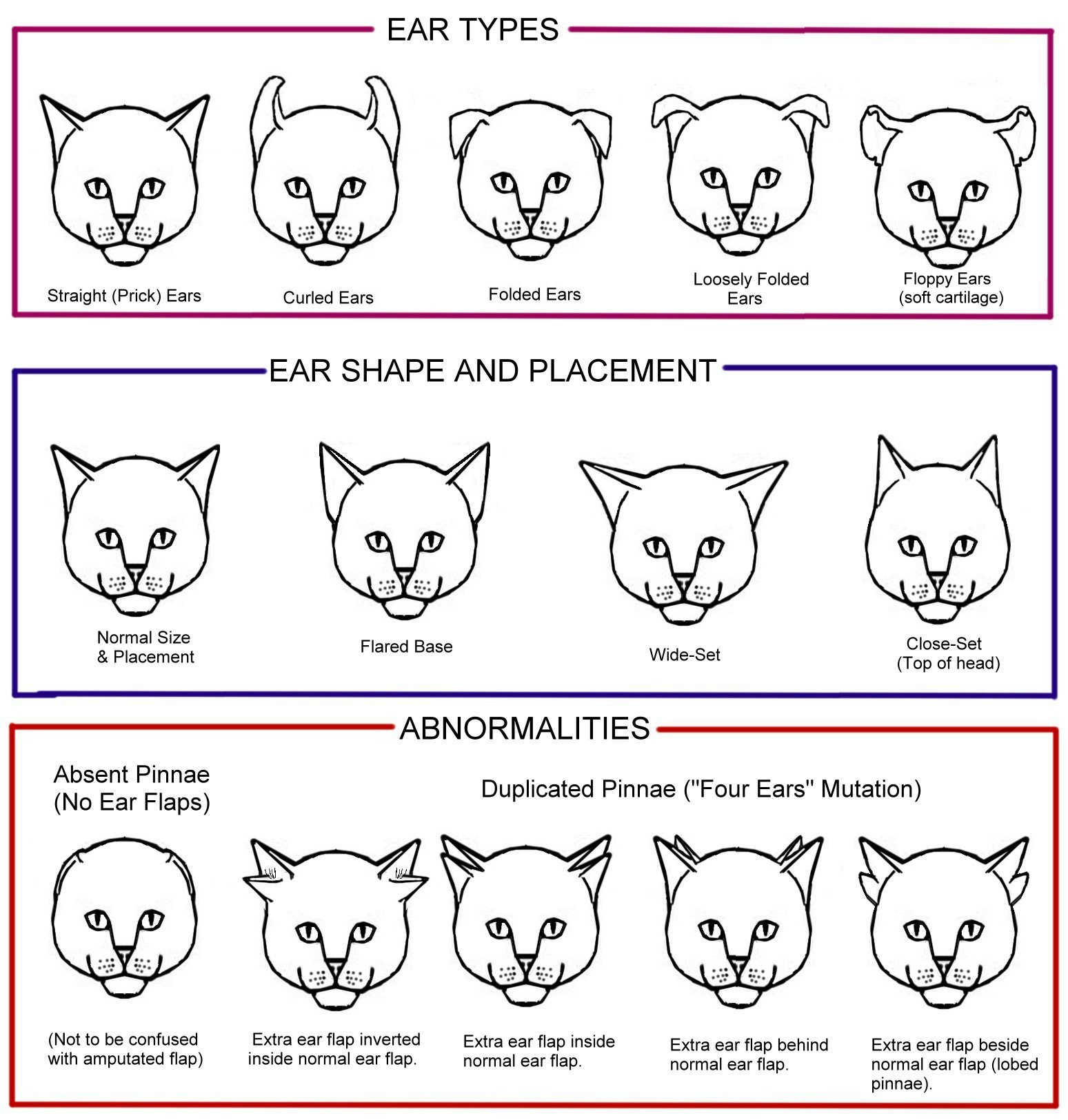
MORE ANOMALIES
If you have come to this page directly from a search engine, please check out
FELINE MEDICAL CURIOSITIES for the full index of topics includingBOOKS ABOUT ANOMALIES
If you are interested in medical curiosities, books worth reading are "Mutants: on the Form, Varieties and Errors of the Human Body" by Armand Marie Leroi and "Anomalies and Curiosities of Medicine Vols 1 and 2" by George M. Gould & Walter L. Pyle. The Gould & Pyle books were published in 1896 and are in the public domain. You can download text-only versions of Gould & Pyle from several websites so don't waste money on text-only versions of the book; but if you want the versions with photos, consider the Kessinger editions. The Leroi book explains why and how some deformities and anomalies happen - the mechanism is the same in cats as it is in humans.
You are visitor number